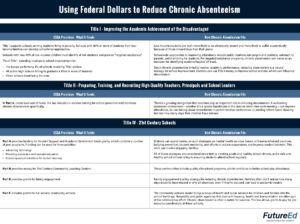With so many states (36 plus the District of Columbia) now using chronic absenteeism as an accountability metric as part of their plans to implement the Every Student Succeeds Act (ESSA), many might wonder how ESSA funding mechanisms can be used to help improve attendance.
There are several pots of money in ESSA that states can tap, including funds targeted at promoting academic success for disadvantaged students. Other funds can go towards engaging parents and families or improving “school conditions for student learning.”
FutureEd, a think tank at Georgetown University, lays out some of the options in a blog post on its website:
- Title I provides more than $15 billion to support schools educating low-income students and school improvement efforts. Since low-income students are both more likely to be chronically absent and more likely to suffer academically because of those missed days, improving attendance becomes an important strategy.
- Title II, which pays for professional development for teachers and staff, specifically mentions chronic absenteeism as a topic for in-service training.
- Title IV provides $1.1 billion for Student Support and Academic Enrichment grants, a block grant program with priorities that include ensuring safe and healthy students. That can pay for improvements to health services, family engagement and school climate, all of which influence attendance. The title also supports 21st Century Learning Centers, Community Schools, and other programs that have proven successful in tackling chronic absence.
Find the full blog post, and an easy to read table, on the Future Ed website.